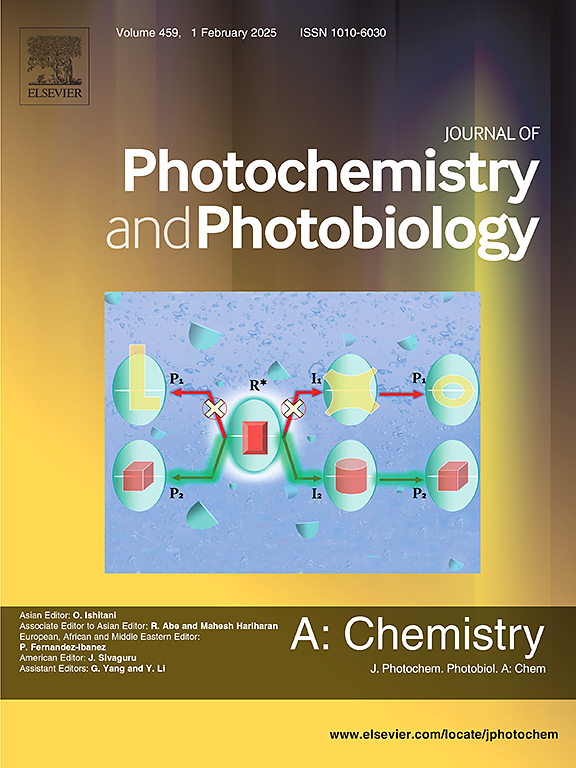Solar/metal activation of persulfate in homogeneous processes for simultaneous degradation of antibiotic and dye pollutants
IF 4.7
3区 化学
Q2 CHEMISTRY, PHYSICAL
Journal of Photochemistry and Photobiology A-chemistry
Pub Date : 2025-05-19
DOI:10.1016/j.jphotochem.2025.116500
引用次数: 0
Abstract
Antibiotics are widely used in human, veterinary and aquaculture for disease control. Edible dyes, on the other hand, are often used in the manufacture of drugs. Both of these can pollute the environment when concentrated in water. In this study, solar-activation of persulfate (PS) in aqueous media was employed for the simultaneous degradation of penicillin-G (PG) drug and rhodamine-B (RhB) dye. Experiments were conducted in a thin-layer flow photo-reactor, irradiated with a standard solar light simulator. Under mild optimum conditions of pH 6.9, PS concentration of 225 mg/L and a reaction time of 70 min, 79.1 % and 90.1 % degradations were achieved for PG and RhB pollutants, respectively. Adding only 0.42 mg/L of and 0.47 mg/L of ions, improved degradation and COD reduction to respectively, 99.7 % and 85.6 %. Alternative relevant homogenous processes were examined and the interference of different coexisting water matrices was studied. Further, contribution of reactive oxygen species was determined and the relevant eleven intermediates were identified based on LC-MS analysis followed by evaluating the product toxicity level with the antibiogram test. This study highlights using the Solar/PS// homogeneous process for the treatment of pharmaceutical and dye wastewaters.

太阳/金属活化过硫酸盐在均相过程中同时降解抗生素和染料污染物
抗生素广泛用于人类、兽医和水产养殖业的疾病控制。另一方面,食用染料经常用于制造药物。这两种物质在水中集中后都会污染环境。本研究采用水介质中过硫酸盐(PS)的太阳活化法同时降解青霉素- g (PG)药物和罗丹明- b (RhB)染料。实验在一个薄层流动光反应器中进行,用标准太阳光模拟器照射。在pH为6.9、PS浓度为225 mg/L、反应时间为70 min的温和优化条件下,对PG和RhB污染物的降解率分别为79.1%和90.1%。仅添加0.42 mg/L的Fe2+和0.47 mg/L的Cu2 +离子,降解率和COD降低率分别达到99.7%和85.6%。考察了不同的相关均质过程,并研究了不同共存水基质的干扰。此外,通过LC-MS分析确定了活性氧的贡献,并鉴定了相关的11种中间体,然后通过抗生素谱测试评估了产品的毒性水平。本研究的重点是利用Solar/PS/Fe2+/Cu2 +均相工艺处理制药和染料废水。
本文章由计算机程序翻译,如有差异,请以英文原文为准。
求助全文
约1分钟内获得全文
求助全文
来源期刊
CiteScore
7.90
自引率
7.00%
发文量
580
审稿时长
48 days
期刊介绍:
JPPA publishes the results of fundamental studies on all aspects of chemical phenomena induced by interactions between light and molecules/matter of all kinds.
All systems capable of being described at the molecular or integrated multimolecular level are appropriate for the journal. This includes all molecular chemical species as well as biomolecular, supramolecular, polymer and other macromolecular systems, as well as solid state photochemistry. In addition, the journal publishes studies of semiconductor and other photoactive organic and inorganic materials, photocatalysis (organic, inorganic, supramolecular and superconductor).
The scope includes condensed and gas phase photochemistry, as well as synchrotron radiation chemistry. A broad range of processes and techniques in photochemistry are covered such as light induced energy, electron and proton transfer; nonlinear photochemical behavior; mechanistic investigation of photochemical reactions and identification of the products of photochemical reactions; quantum yield determinations and measurements of rate constants for primary and secondary photochemical processes; steady-state and time-resolved emission, ultrafast spectroscopic methods, single molecule spectroscopy, time resolved X-ray diffraction, luminescence microscopy, and scattering spectroscopy applied to photochemistry. Papers in emerging and applied areas such as luminescent sensors, electroluminescence, solar energy conversion, atmospheric photochemistry, environmental remediation, and related photocatalytic chemistry are also welcome.

 求助内容:
求助内容: 应助结果提醒方式:
应助结果提醒方式:


